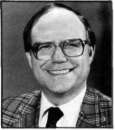 |
Home | Search | Browse | About IPO | Staff | Links |
 |
Home | Search | Browse | About IPO | Staff | Links |
|
Politics King of sports and sportsmen 
By CHARLES N. WHEELER III In a new twist on the time-honored government tradition of helping the needy, Gov. James R. Thompson and the Illinois General Assembly worked tenaciously last month to take care of some of the state's wealthiest citizens. The beneficiaries of their labors are a handful of well-to-do sportsmen whose goodies include a new stadium for the Chicago White Sox and a rebuilt Arlington Park Race Track. Of course, the proposals were not billed as handouts for millionaires. Instead, the governor and other enthusiasts labeled them important economic development measures, vital to Illinois jobs. Either way, pumping $80 million into the state's racing industry by legalizing off-track betting and slashing wagering taxes is easy. So is backing a new stadium with higher Chicago hotel taxes and pledges of $10 million a year in state and city grants. The hard part will come when the 85th General Assembly convenes on January 14. That's when, after practicing with charity for rich folks, the governor and lawmakers will face the real test of providing for the truly needy among us while nurturing economic growth. Among the major challenges, social and governmental, they'll face are these: • State programs to help people suffering from mental illness and developmental disabilities came under heavy fire during the gubernatorial campaign. Postelection reports, including some internal ones, show there's more to the problem than simple political rhetoric. Seriously mentally ill persons have great difficulty in obtaining needed help because of the nature of their illnesses, a lack of resources and poor coordination of services, an intensive study by the League of Women Voters of Illinois found, and dedicated workers in the state Mental Health Department complain that professional concerns have been sacrificed to politics and economics. Underlying such criticism is a problem that has troubled policymakers for more than two decades: how to assure adequate and appropriate care for the mentally ill and developmentally disabled in community-based settings rather than in state-operated institutions. • Welfare grant levels, already scandalously low, now cover less than half the minimum amount a family requires to survive, under the state Public Aid Department's new 1987 guidelines. In fact, some advocates contend, inadequate grants are a significant factor in driving up the number of homeless, especially women and children. Sheltering those unfortunates, of course, is another serious social concern. • The 1985 school reform package will head into its third year in September facing critical growing pains. Budget constraints have prevented full implementation of many reform programs, and others ready to move from pilot stage to statewide use also will need more dollars. In addition, lawmakers must rethink the sun-setting school aid formula, a complex equation by which some $2 billion of general state aid is distributed each year. Suburbanites in particular dislike the current formula, which favors less affluent districts. Quality education is essential, of course, if the state is to capture tomorrow's jobs. • Ironically, the same week Illinois legislators were talking about gambling parlors and baseball parks as economic development, Lafayette, Ind., was chosen as the site for a $500 million Japanese auto and truck production plant for whicgh Springfield had been considered. True, Illinois already had won Chrysler-Mitsubishi some 13 months earlier. But the fact remains that neither a new Arlington Heights race track nor a new White Sox park will generate the kind of high-paying jobs a solid manufacturing base will. 4/January 1987/Illinois Issues And while the state's generosity borders on the bottomless for out-of-state prospects, much less has been done to keep struggling home-grown plants healthy. Their biggest headaches, business leaders say, are the cost of worker's compensation, unemployment insurance and liability coverage. Given the reluctance of most legislators to reduce benefits for laid-off or injured workers, or for accident victims, perhaps the time has come to consider whether society as a whole should share in the burden through commitment of state funds, for example to pay catastrophic awards to injured workers or customers. • Another factor with major impact on the state's jobs future is the Illinois tax structure, particularly in the wake of new federal tax laws. To take advantage of federal income tax revisions, state Comptroller Roland W. Burris has suggested increasing the rate of the state income tax, which remains deductible for federal tax purposes, while reducing now nondeductible sales taxes. That idea merits study by the blue-ribbon committee reviewing the state's tax structure, especially the heavy reliance on sales taxes. The panel also might want to consider whether local property owners bear too much of the burden of paying for public education; if so, would a school district income tax, with some mandated real estate tax abatement, make sense? • If Illinoisans want better highways, the governor said during the last campaign, they must be willing to pay for them. That could mean a nickel-a-gallon motor fuel tax increase, or higher license plate fees. But good roads, like good schools, are a key ingredient for economic development. Probably the toughest challenge facing Thompson and the legislature in the coming months is finding ways to address these social and economic issues without large cash outlays. The fiscal year starting July 1 is expected to be extremely tight, even without dramatic increases for new or expanded initiatives, and there's been little enthusiasm for general tax increases. As the governor and lawmakers begin to tackle this agenda, let's hope they can do as well for the rest of us as they did for the racing impressarios and the baseball barons. 5/January 1987/Illinois Issues
|